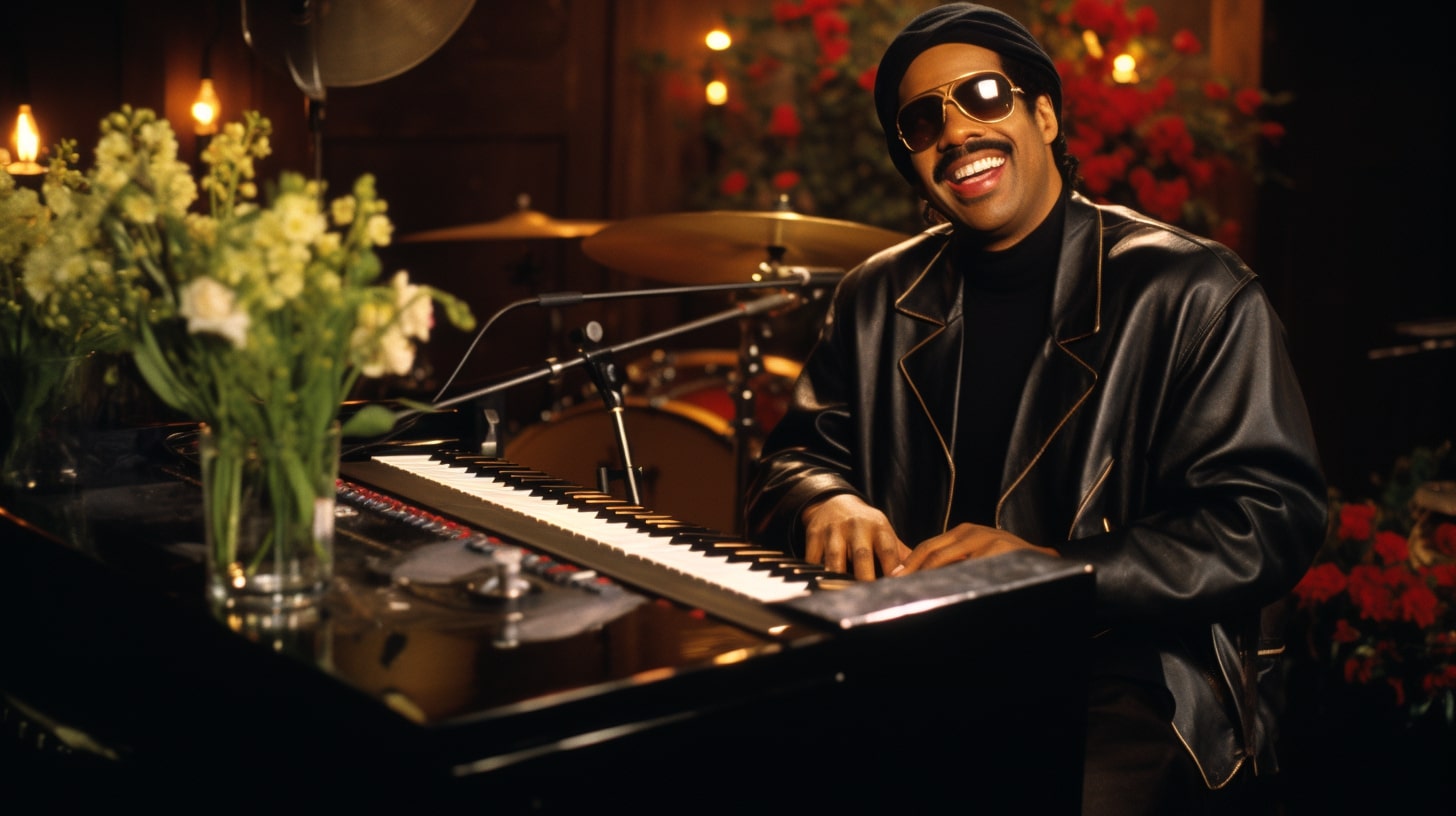Stevie Wonder is a phenomenal musician known for his remarkable instrumental abilities. Despite being blind since shortly after birth, he rose to prominence in the music industry with his exceptional talent.
As one of the most influential and innovative musicians of the 20th century, Stevie Wonder’s mastery of various instruments has left a lasting impression on the world of music.
Stevie’s instrumental versatility has played a crucial role in shaping his iconic sound and securing his place as a musical legend.
Contents
Early Life and Musical Beginnings
Stevie Wonder was born Stevland Hardaway Judkins in Saginaw, Michigan, on May 13, 1950. He became blind shortly after birth, which did not hinder his incredible musical talent. At a young age, he and his family moved to Detroit, Michigan, where he first showcased his gift by singing in a church choir.
As a child prodigy, Wonder taught himself to play various instruments, including piano, harmonica, and drums. By the age of 10, he had already started performing on street corners and at parties and dances as part of a singing duo called Stevie and John. He studied classical piano and music theory, contributing to his exceptional singing, songwriting, and music skills.
At 11 years old, Wonder made his recording debut as Little Stevie Wonder with the album “Tribute to Uncle Ray,” paying homage to the legendary musician Ray Charles. He quickly gained attention and was soon signed by Berry Gordy to the Tamla subsidiary of the Motown family.
Wonder enjoyed early success as a young artist with his groundbreaking hit “Fingertips, Pt. 2.” At the age of 12, this song topped the Billboard pop and soul charts, solidifying his position as a prodigious singer, songwriter, and multi-instrumentalist in the music industry. Success continued for “Little Stevie Wonder” as he became an integral part of the Motown label. With the talented group of musicians known as the Miracles, Wonder imposed his distinctive style as both a musician and producer for the company.
In conclusion, despite his early childhood blindness, Stevie Wonder’s prodigious talent and determination led him to become one of the most iconic and multifaceted musicians of the 20th century. From playing multiple instruments to writing and producing his own music, his contributions to the world of music remain unparalleled.
Main Instruments
Harmonica
Stevie Wonder is known for his exceptional skills and proficiency in playing the harmonica. He began playing the instrument at a very young age and has showcased his talent in many of his songs. The harmonica has become one of his signature sounds, and he has often utilized the chromatic harmonica to produce unique and innovative tones in his music.
Keyboard and Piano
A talented multi-instrumentalist, Stevie Wonder has demonstrated great prowess with keyboard instruments, such as the piano and organ. From a young age, he showed a natural aptitude for these instruments, which enabled him to create heartfelt and timeless melodies.
He has also explored different keyboard-based instruments, including the synthesizer and clavinet. His exploration and experimentation with synthesizers have left a lasting impact on various music genres and the development of electronic instruments.
Drums and Percussion
Stevie Wonder is well-versed in drums and various percussion instruments, such as congas and bongo drums. His ability to play drums adds a rhythmic and powerful layer to his music, supporting and enhancing his melodies and harmonies. His incorporation of various percussion instruments, including congas and bongos, showcases his versatility as a musician and his willingness to experiment with different musical styles and elements.
Additional Instruments
Stevie Wonder is well-known for his proficiency in several instruments. Alongside his primary instruments, like the piano and harmonica, he has demonstrated a versatile ability to perform with various other instruments. In this section, we’ll explore some of the additional instruments Stevie Wonder has played throughout his illustrious career.
A significant part of Stevie’s talent lies in his ability to play stringed instruments. One such instrument is the guitar, with which he has showcased his impressive skills in live performances and studio recordings. He has also played the bass guitar, providing a foundational groove to some of his songs. Stevie has been known to include string sections in his music, enriching his compositions by incorporating orchestral elements.
In addition to stringed instruments, Stevie has explored the world of wind instruments, such as the melodica. This unique instrument combines a keyboard and a harmonica, allowing the player to produce melodies with a distinct, breathy tone. Stevie has effectively utilized the melodica’s characteristic sound to contribute depth and texture to his music.
Stevie’s versatility also involves percussive instruments. He has played the bongos, a pair of small, hand-held drums that are popular in Latin American music. Stevie Wonder adds rhythmic variety and a distinctive cultural flavor to his music by including this instrument in his repertoire.
An intriguing aspect of Stevie Wonder’s musical exploration is his discovery of the harpejji. This modern and unique instrument features strings stretched across a flat surface, played by tapping the strings with fingers, much like a piano. The harpejji, specifically the K24 model, captivated Stevie, and he has since incorporated it into his performances, further expanding his already extensive musical range.
From acoustic guitars to innovative digital instruments, Stevie Wonder has navigated through a diverse range of musical tools, showcasing his unmatched creativity and adaptability. His ability to seamlessly integrate various instruments into his music, such as chorus sections and orchestral strings, demonstrates his dedication to creating a rich, multifaceted soundscape that continues to captivate listeners worldwide.
Songwriting, Production, and Awards
Stevie Wonder is a versatile and talented artist known for his extraordinary skills in playing various instruments, songwriting, and production. His music spans various genres, including pop, soul, jazz, and funk, showcasing his broad range of musical abilities.
Wonder began his career at a young age as a child prodigy and went on to become one of the most successful musicians of the 20th century. He has released numerous hit records, which consistently appeared on the Billboard Hot 100 and gained widespread acclaim. Stevie Wonder produced and co-produced several of his own albums, like the 1970s “Signed, Sealed, Delivered,” which featured the No. 1 R&B title track and a top 5 R&B hit.
Throughout his illustrious career, Wonder has received numerous awards and accolades for his contributions to the music industry. He has won 25 Grammy Awards, setting a record for the highest number among male solo artists. Additionally, he was inducted into the Songwriters Hall of Fame in 1983 and has received the Johnny Mercer Award and Sammy Cahn Lifetime Achievement Award.
Utilizing technology and innovations in his music production, Stevie Wonder explored various digital and analog instruments to create his signature sound. He was one of the early adopters of the synthesizer, using the TONTO (The Original New Timbral Orchestra) to expand the boundaries of pop and R&B. This device was a groundbreaking piece of technology that allowed him to incorporate innovative sounds and textures into his music.
In conclusion, Stevie Wonder’s impressive career demonstrates his exceptional talent in playing multiple instruments, songwriting, and music production. His mastery of various genres, from pop to soul and technology, has solidified his standing as one of the most influential musicians of the 20th century.
Notable Performances and Collaborations
Stevie Wonder, a multi-talented musician, played various instruments throughout his career, such as the piano, keyboards, harmonica, and drums. His creativity and skill are showcased in numerous performances and collaborations.
In the 1970s, Stevie Wonder produced a string of remarkable albums, including “Innervisions,” “Talking Book,” and “Songs in the Key of Life.” These albums featured iconic tracks like “Superstition,” “Higher Ground,” “Sir Duke,” “Do I Do,” “I Wish,” and “Isn’t She Lovely.” Many of these songs are marked by Stevie’s exceptional instrumental prowess, often playing multiple instruments on a single track and contributing to the lyrics and arrangement.
Stevie Wonder’s collaboration with Paul McCartney resulted in the hit song “Ebony and Ivory,” symbolizing racial harmony. The two artists performed this song together on several occasions, showcasing their musical chemistry and shared message of unity.
As an in-demand performer, Stevie also shared the stage with Smokey Robinson and The Miracles, singing background vocals and playing the harmonica on “The Tears of a Clown.” Their talents combined, drawing attention to the rich musical landscape of the time.
Throughout his career, Stevie Wonder has been recognized by major industry players such as Rolling Stone magazine and has made numerous television appearances. One notable performance was his appearance on Sesame Street, where he performed a unique version of “Superstition” with a distinct chorus to engage the young audience. This performance demonstrated his ability to adapt and connect with diverse audiences while showcasing his instrumental skills.
In summary, Stevie Wonder’s notable performances and collaborations reflect his mastery of various instruments and his long-lasting impact on the music world. His innovative work has influenced a wide range of artists and continues to captivate listeners to this day.
Personal Life and Legacy
Stevie Wonder, born Stevland Hardaway Judkins and later known as Stevland Hardaway Morris, is an American singer-songwriter, composer, and multi-instrumentalist. He was born on May 13, 1950, in Saginaw, Michigan, and became blind shortly after birth. Despite his disability, Wonder became a child prodigy, learning to play various instruments at a young age.
Wonder’s remarkable talent was evident from an early age, as he taught himself to play the harmonica, piano, and drums before the age of 10. As a child, he attended Fitzgerald Elementary School in Detroit and formed a singing partnership with a friend, performing on street corners and occasionally at parties and dances.
Wonder’s personal life includes his relationships and raising a family. One of his daughters, Aisha Morris, has followed in her father’s footsteps in the music industry. Well-known for his unique one-man-band performances and contributions to pop music, Stevie Wonder is regarded as an inspirational figure in the world of music.
Throughout his long-standing career, Wonder has received numerous honors and accolades for his work as a singer-songwriter and composer. He has seen success not only on the American charts but also on the UK Singles Chart, showcasing his worldwide appeal.
Stevie Wonder has been the subject of various documentaries, including PBS specials, and featured in multiple Google Doodles, further solidifying his legacy as an influential, blind man in the music industry who impacted countless lives with his numerous talents.


